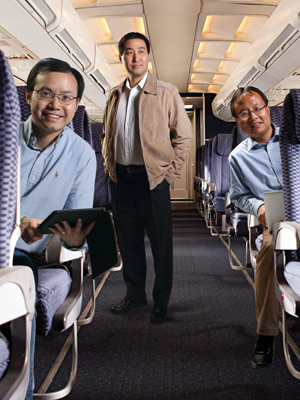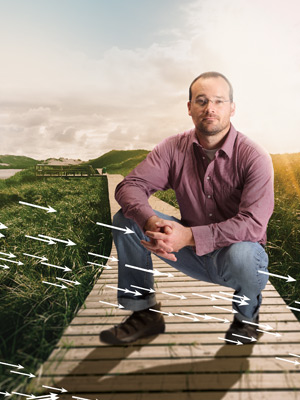In the Air and Under the Sea
Baylor Research is Making an Impact
In the next five years, Dr. Liang Dong envisions a day when airline passengers in flight will be able to make a call from their cell phones to someone on the ground or Skype during an international flight.. As part of the communication technology he and a team of researchers are developing, he sees flights becoming safer and technology becoming more widely accessible.
Dr. Yang Li
Assistant Professor
Electrical & Computer Engineering
Dr. Liang Dong
Associate Professor Electrical & Computer Engineering
Dr. Jonathan Hu
Assistant Professor
Electrical & Computer Engineering
“I’m the type of person who wants to make good use of time. I travel a lot,” said Dong, associate professor of electrical and computer engineering.
He and Drs. Jonathan Hu and Yang Li, assistant professors of electrical and computer engineering, are developing a high definition wireless in-flight entertainment and communications system for VIP and military flights. He says that one day the growing technology will make its way to the mainstream consumer market. The system mirrors a wireless home network.
In order for each passenger to stream high definition video on their personal devices, the technology requires an extremely high data rate. “In the near future, passengers on board should be able to … update their social status and watch Netflix using their own wireless devices, just as what they do in their own houses,” said Li. “This seamless transition from land to air will enable our dream of communicating anywhere, anytime,” he added.
“Unaccompanied minors on the airplane will be able to interact with their family members on the ground,” said Hu. In case of a medical emergency, “flight personnel can have video diagnostics with doctors on the ground.”
Their lab hallway in the Baylor Research and Innovation Collaborative facility, also known as the BRIC, simulates the length of a plane and is used to test whether video can be streamed clearly in different parts of a plane. Waco’s L-3 group has provided the researchers funding over the last two years to further the work. L-3 provides a range of communication and electronic systems and products used on military and commercial platforms. They also focus on national security solutions
Passenger Safety
With terrorism and missing flights in international headlines, Dong says the technology has implications for passenger safety in three areas.
The researchers are building different levels of security so that those with varying levels of authorization could have access to the network. Second, flight crews would be able to use their hidden devices to communicate discreetly and quickly. Finally, particularly in a military scenario, the pilot could access cameras pointed at the payload to monitor the plane in real time.
The next step for the team is to refine the fiberoptic backbone, look at the weight of the technology, power consumption and installation costs, and make sure there’s no radio interference with the navigation system. “We will talk with the FAA to make sure we understand the regulations. We will do a lot of measurement, especially in flight,” said Dong.
Under the Sea
Assistant Professor
Mechanical Engineering
After the Deepwater Horizon oil spill in the Gulf of Mexico in April 2010, BP committed to pay $500 million over 10 years to support research. The goal is to gain a better understanding of, build a response to and mitigate the impact of a potential spill on marine and coastal ecosystems.
Dr. Joseph Kuehl, assistant professor of mechanical engineering, is working to do just that. He’s part of a consortium studying ocean dynamics in the Gulf through a $16 million GoMRI (Gulf of Mexico Research Initiative) grant. His research focuses on the fate of hydrocarbons when they enter the ocean and, in particular, how ocean topography influences that fate.
Through their research, he and his collaborators identified a particular type of wave on the Gulf of Mexico slope and found it to have a shorter period than scientists previously thought existed in the region. “Finding this four-day wave was significant because it changes the time scale of the dynamics people might have to consider when predicting oil spill trajectories,” said Kuehl. He noted that the wave is stronger toward the floor of the ocean.
The findings are important because traditionally people think about the oil that floats to the surface, but with the BP spill, there was a large deep oil plume, which would have interacted with these waves.
The ultimate goal of the research, Kuehl said, is to predict where the oil will go, how it will affect the ecosystem, whether it will reach the coast and whether it will affect any fisheries or marshland, so that a response plan can be deployed. “It’s a pretty significant concern,” said Kuehl. “A deep plume could be going in the complete opposite direction of what’s going on at the surface.” Eventually it will run into the ocean slope and there are large questions about where it will go from there, he said.
Kuehl also studies the geophysical fluid dynamics of the Loop Currents, or flow of water, that enters and exists in the Gulf of Mexico and South China Sea. His lab research confirmed that multiple states with hysteresis – dependence of a system on its current and past inputs – exist. “It was the first time anyone had actually shown (this) experimentally … where you have a competition between vorticity and inertia,” said Kuehl.
Scientists have long struggled to understand Loop Currents, Kuehl said. “If you have an oil spill, the Loop Current is going to push that oil around. If you don’t understand it, it’s going to be much more difficult to understand what’s going on with the oil,” he added.
When asked about his concerns working offshore, Kuehl said with a laugh, “I don’t have any great fears, but it turns out I get really seasick.”

